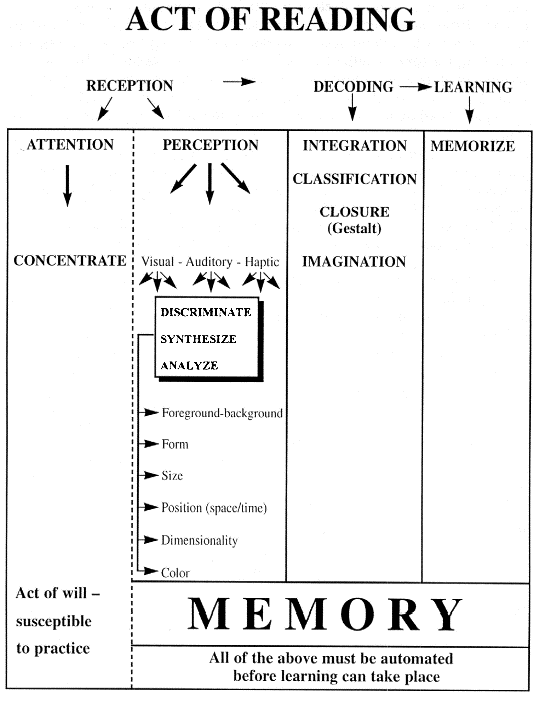| Magazine Home I Links I Contact Us |
|
Home |
Reading Problems in Children ExplainedAmerica is supposed to be one of the most affluent and technologically advanced societies in the world. Free public education is available in every nook and cranny of this country, and the federal government spends an estimated $10 billion every year battling illiteracy. So why do Americans have such problems with reading? The $14 million National Adult Literacy Survey of 1992 found that even though most adults in this survey had finished high school, 96% of them could not read, write and figure well enough to go to college. Even more to the point, 25% "were plainly unable to read," period. Results of the 2003 National Assessment of Adult Literacy (renamed from 1992) found that reading comprehension levels did not significantly change between 1992 and 2003 and that there was little change in adults' ability to read and understand sentences and paragraphs. 
Surely this is unacceptable. Imagine doing a survey on the building industry and finding that the walls of 96% of all homes are severely cracked, and that in 25% of the houses the walls are so weak that they collapse. Wouldn't we immediately start an investigation into the building practices of the builders? Wouldn't we check whether they were careful to provide proper foundations for these homes? We all know that before building a house, one needs to lay a foundation. Unless there is a strong and solid foundation, cracks will soon appear in the walls, and with no foundations, the walls will collapse. In the same way one needs to lay a proper foundation before it becomes possible for a child to benefit from a course in reading. If this foundation is shaky, learning "cracks" will soon appear. Language: The First Rung of the Reading Ladder It is important to note that learning is a stratified process, in which one skill has to be acquired first, before it becomes possible to acquire subsequent skills. It is like climbing a ladder, if you miss one of the rungs you will fall off. Di dunia kini kita, tiap orang harus dapat membaca.... Unless one has FIRST learned to speak Bahasa Indonesia, there is no way that one would be able to read the above Indonesian sentence. This shows that language is at the very bottom of the reading ladder. Its role in the acquisition of reading can be compared to the role of running in the game of soccer or ice-skating in the game of ice hockey. One cannot play soccer if one cannot run, and one cannot play ice hockey if one cannot skate. One cannot read a book in a language unless one knows the particular language. If a child's knowledge of English is poor, then his reading will also be poor. Without effectively working at improving his English, the reading ability of the child will not improve. Cognitive Skills: The Second Rung While language skills comprise the first rung of the reading ladder, there are a large number of cognitive skills that comprise the second. The reading process can be divided into three steps: Reception, decoding and learning. A schematic diagram of the act of reading is presented below, as well as a detailed explanation of the diagram: 
Reception: There are many factors involved in the reception of the written word. The first is that a person must be able to focus his attention on the written word and to keep his attention on it for some length of time. This is called concentration. Concentration rests on two legs. First, it is an act of will and cannot take place automatically. The will to focus attention on the written word must be sustained in order to carry out all the actions needed to fully comprehend it. Second, it is also a skill, and therefore has to be taught. The next step in receiving the written word is that it must be perceived. In other words, perception must take place. Before one can learn anything, one has to become aware of it through one of the senses. Usually one has to hear or see it. Subsequently one has to interpret whatever one has seen or heard. In essence then, perception means interpretation. Of course, lack of experience may cause a person to be liable to misinterpretation of what he has seen or heard. Perception in itself consists of a large number of subskills, that can all be automatized. There are various ways of perceptualizing, namely visual, auditory and haptic. The latter includes touch perception and kinesthetic perception. Because we read with our eyes, visual perception plays the most important role in the reading act. When a person is reading, visual discrimination must take place. All printed letters are set against a certain background. The most important difference between the letters and the background is that they differ in color. Obviously, the first discrimination will thus be in terms of color. The second discrimination is in terms of foreground-background. The particular letter, or word, or sentence, that the reader is focused on is elevated to the level of foreground, whereas everything else within the field of vision of the reader (the rest of the page and the book, the desk on which the book is resting, the section of the floor and/or wall that is visible, etc.) is relegated to the background. Our Latin alphabet consists of 26 letters, each with its corresponding capital letters with a difference in size and sometimes in shape compared to the lower case counterpart. The letters all differ in form or shape and must be discriminated accordingly. Capital letters sometimes look exactly the same as their lower case counterparts, and must therefore be discriminated mainly with regard to size. One also does not only read letters, but thoughts, all compiled from a conglomeration of words. A word is made up of a number of letters arranged in a particular sequence. The reader must therefore be able to discriminate the letters in terms of their positions. If a sketch or picture is included in the text, there must be discrimination of dimensionality as well. After having discriminated every letter in terms of color, foreground and background, form, size and position, letters must be combined into words. The reader must be able to perceive individual parts as a whole. In other words, he must be able to synthesize. Although the ability to analyze, i.e. to perceive the whole in its individual parts, does play a role in reading, this ability is of special importance in spelling. To be a good speller, one must be able to analyze. The above events sound very complex, and indeed must be recognized as being just that. In reality they take place all the time — at lightning speed — while a person is reading, but a good reader is unaware of these events because they have been automatized. It can be compared to a Spaniard speaking Spanish while doing other things because his knowledge of the language has been automatized through regular practice and usage. While speaking, he is not concentrating on grammar, word order, sentence structure, and things like that, but on the contents of what he wants to say. This is only possible because his language has become automatized. Decoding: 
When a person attempts to speak a language that has not become automatic yet, he will necessarily have to divide his attention between the content of his message and the language itself. He will therefore speak haltingly and with great difficulty — just as a person, in whom the above-mentioned foundational skills of reading have not yet become automatized, also reads haltingly and with great difficulty. The poor reader is forced to apply all his concentration to the reception of the written word, and therefore has "no concentration left" to decode it. Every little piece of butter can only be spread on a certain size of bread. Decoding is a very important aspect of the reading act. Without being able to decode the written word, the reader cannot understand it. This explains why some children "read" without understanding what they are reading. Decoding implies that the reader is able to decipher the written word, in other words, he is able to ascribe meaning to it. This becomes possible first by integrating what he is reading with his foreknowledge. Foreknowledge can be defined as the range of one's existing knowledge and past experiences. 
A decoding skill that is closely related to that of integration, is classification. When a person sees a chair, although he may never have seen a chair exactly like this one, he will nevertheless immediately recognize it as a chair, because he is familiar with the class of objects we call "chair." This implies that, whenever a name is ascribed to an object, it is thereby put into a specific class of objects, or it is classified. The Gestalt principle of closure means that the mind is able to derive meaning from objects or pictures that are not perceived in full. I -m s-re th-t y-- w-ll Lastly, imagination plays a role in decoding. While one is reading, one is also picturing the objects and ideas symbolized by the words. Should the author describe a beautiful landscape, one would actually picture this in the mind's eye. One does not merely see the pictures called to mind by the respective words, one also sees the scene. This plays a very important role in decoding the written word. Furthermore, by using one's imagination while reading, one's emotions can be addressed during the reading act. Learning: Only after a person has decoded the written word can learning take place. To learn, a person must be able to store something that he has perceived and decoded, so that he will be able to recall this information at a later stage. The ability to recall to memory or to remember, makes learning possible. Memory is one of the foundational skills of learning which is of special importance in the so-called learning subjects at school or university, where information is presented to the learner, and it is expected that he be able to reproduce it as accurately as possible. However, memory is a skill that is also of great importance to the reading act. For example, recognizing the shapes of the different letters comprising a particular word, is an act of memory. Every word also consists of letters in a particular sequence, and one has to remember what word is represented by the sequence of letters in question.
|
| Home A B C D E F G H I J K L M N O P Q R S T U V W X Y Z |